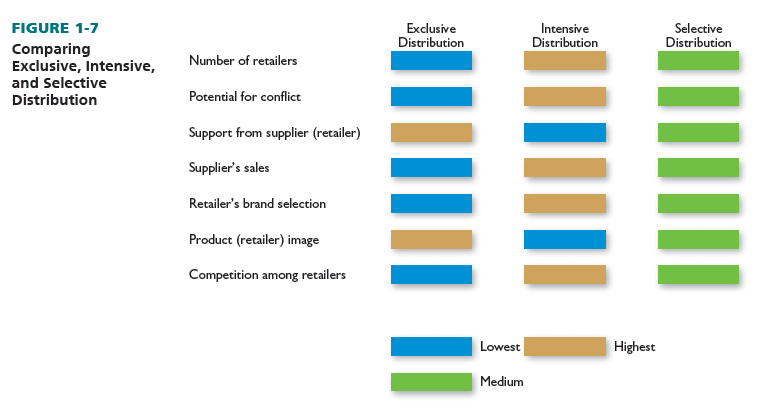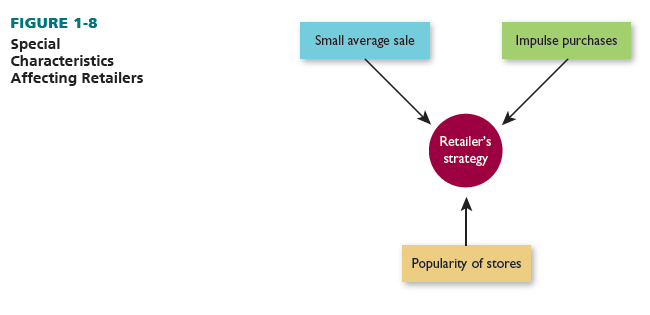Three factors that most differentiate retailing from other types of business are noted in Figure 1-8 and discussed here. Each factor imposes unique requirements on retail firms.
The average amount of a sales transaction for retailers is much less than for manufacturers. The average sales per customer transaction in retailing is low. The average supermarket transaction is about $30.00.8 In comparison, Home Depot’s average sales transaction in 2015 was $58.55.9 The average sales transaction per shopping trip is well under $100 for department stores and specialty stores. This low amount creates a need to tightly control the costs associated with each transaction (such as credit verification, sales personnel, and bagging); to maximize the number of customers drawn to the retailer, which may place more emphasis on ads and special promotions; and to increase impulse sales by more aggressive selling. However, cost control can be tough. For instance, inventory management is often expensive due to the many small transactions to a large number of customers. A typical supermarket has several thousand customer transactions per week, which makes it harder to find the proper in-stock level and product selection. Thus, retailers are expanding their use of computerized inventory systems.

 Final consumers make many unplanned or impulse purchases. Surveys show that a large percentage of consumers do not look at ads before shopping, do not prepare shopping lists (or do deviate from the lists once in stores), and make fully unplanned purchases. This behavior indicates the value of in-store displays, attractive store layouts, and well-organized stores, catalogs, and Web sites. Candy, cosmetics, snack foods, magazines, and other items are sold as impulse goods when placed in visible, high-traffic areas in a store, catalog, or Web site. Because so many purchases are unplanned, the retailer’s ability to forecast, budget, order merchandise, and have sufficient personnel on the selling floor is more difficult.
Final consumers make many unplanned or impulse purchases. Surveys show that a large percentage of consumers do not look at ads before shopping, do not prepare shopping lists (or do deviate from the lists once in stores), and make fully unplanned purchases. This behavior indicates the value of in-store displays, attractive store layouts, and well-organized stores, catalogs, and Web sites. Candy, cosmetics, snack foods, magazines, and other items are sold as impulse goods when placed in visible, high-traffic areas in a store, catalog, or Web site. Because so many purchases are unplanned, the retailer’s ability to forecast, budget, order merchandise, and have sufficient personnel on the selling floor is more difficult.
Despite the inroads made by nonstore retailers, most retail transactions (more than 90 percent) are still conducted in stores—and will continue to be in the future. Many people like to shop in person; want to touch, smell, and/or try on products; enjoy browsing for unplanned purchases; feel more comfortable taking a purchase home with them than waiting for a delivery; and desire privacy while at home. This store-based shopping orientation has implications for retailers; they must work to attract shoppers to stores and consider such factors as store location, transportation, store hours, proximity of competitors, product selection, parking, and ads.
Source: Barry Berman, Joel R Evans, Patrali Chatterjee (2017), Retail Management: A Strategic Approach, Pearson; 13th edition.

Thank you for the auspicious writeup. It in fact was a
amusement account it. Look advanced to far added agreeable from you!
By the way, how could we communicate?
Nice post. I learn something totally new and challenging on websites I stumbleupon everyday.
It’s always helpful to read through articles from other writers and use something from other web sites.
This is very interesting, You are a very skilled blogger.
I’ve joined your feed and look forward to seeking more of your magnificent post.
Also, I have shared your website in my social networks!
I have read some good stuff here. Certainly worth bookmarking for revisiting. I surprise how much effort you put to make such a magnificent informative site.